Spectacle & Ceremony
Westminster Hall and Coronation Banquets
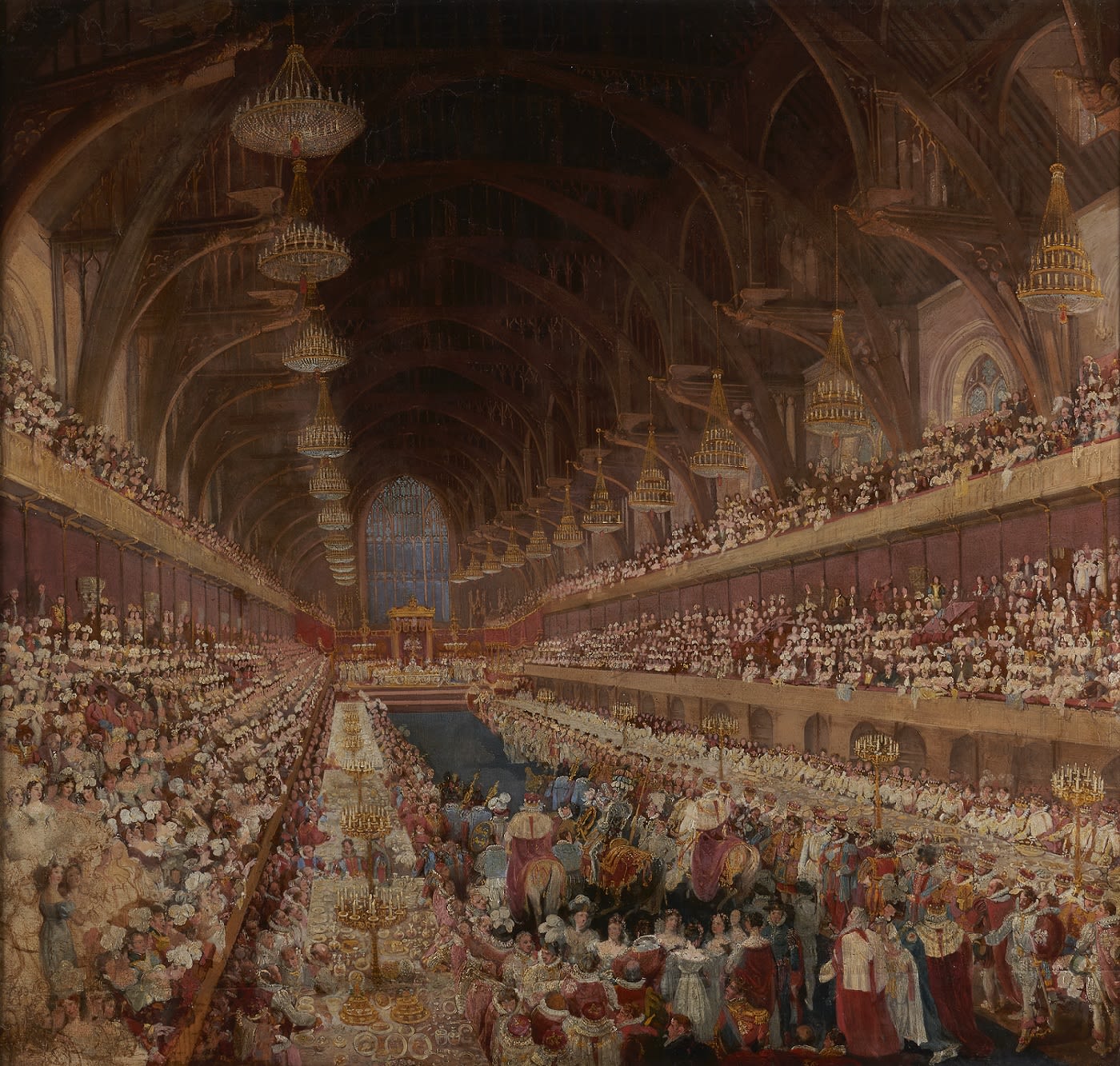
Westminster Hall is the oldest building in the UK Parliamentary estate.
What makes it such an astonishing building is not simply its great size and the magnificence of its roof, but its central role in British history.
In and around the Hall, grew up the major institutions of the British state: Parliament, the law courts and various government offices.
From 1189 to 1821, Westminster Hall was the traditional venue for coronation banquets honouring newly-crowned monarchs.
On the day of the coronation, the procession to Westminster Abbey would begin at Westminster Hall. A large crowd would gather to watch the procession go between the two buildings.
The coronation procession of his Majesty King George the Fourth, July 19th 1821, colour lithograph by Charles Joseph Hullmandel after original by George Scharf.
© Parliamentary Art Collection, WOA 1292
The monarch would be crowned in the Abbey before returning to Westminster Hall for the Coronation Banquet.
This image shows George IV being crowned.
The King seated in St. Edward’s Chair Crowned by the Archbishop of Canterbury, 19th July 1821 in Sir George Nayler, The Coronation of his most Sacred Majesty King George the Fourth (London, 1839).
© Parliamentary Archives, LGC/8/1/11
The first coronation banquet known to have been held in the Hall was for Richard I in 1189; the last, and the most spectacular and expensive, was George IV’s on 19 July 1821, 200 years ago.
Some queens crowned separately from their husbands had their own feasts, including Eleanor in 1236 and Anne Boleyn in 1533. Charles I was the only Monarch not to hold a banquet.
The purpose of the banquet was to demonstrate the Monarch’s magnificence and generosity and to renew the relationship with his or her leading subjects. This was reflected in the status of the guests, the quality and quantity of food (Edward I’s banquet lasted several days), costumes, ceremonial and music.
‘Whatever the world could afford to create pleasure and magnificence was there brought together from every quarter.’
Matthew Paris wrote of Queen Eleanor’s banquet in 1236, in Chronica Majora.
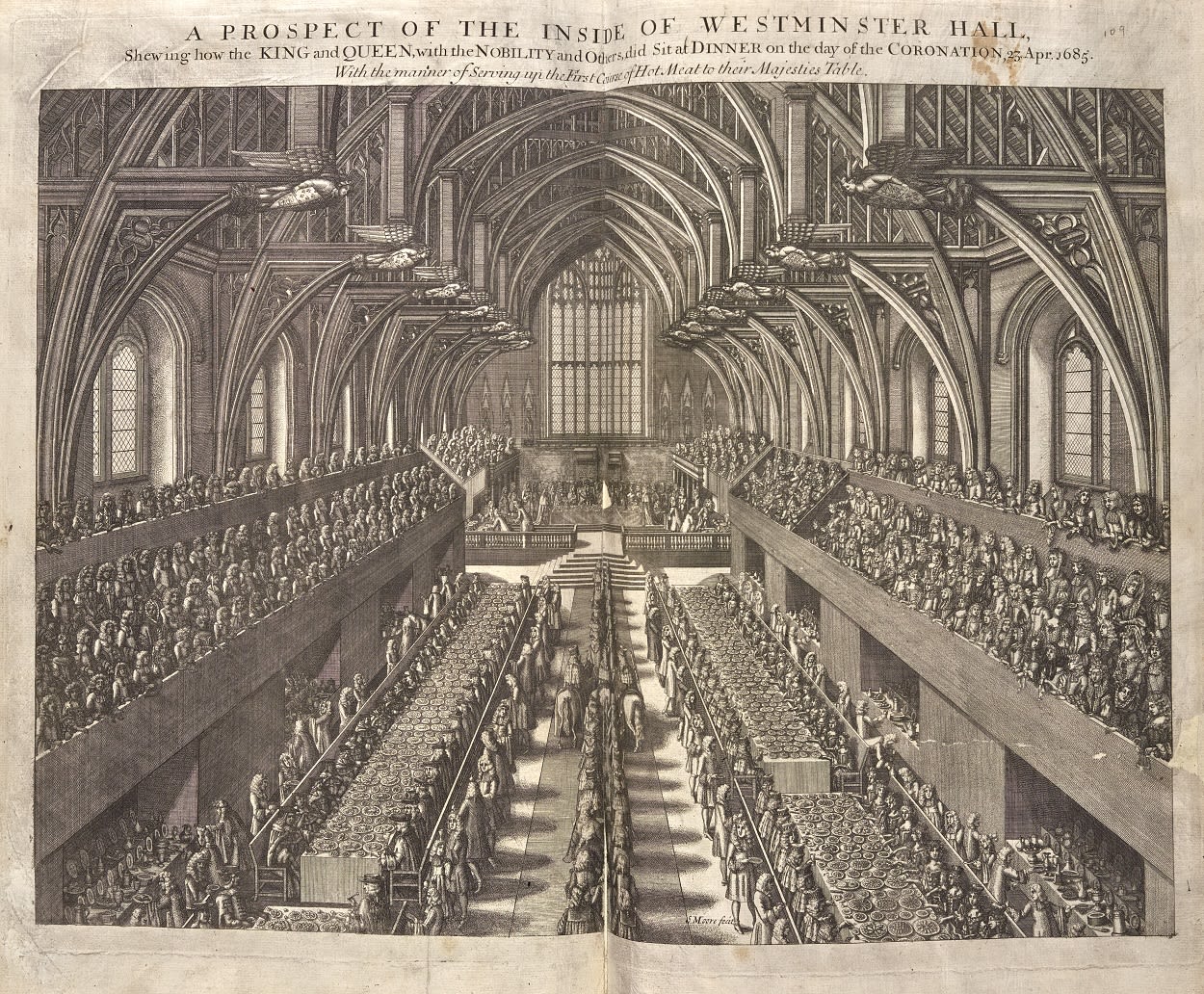
By tradition, the Lord Great Chamberlain and the Earl Marshal were in charge of organising the banquet.
In 1821 the office of Lord Great Chamberlain was held jointly by the 21st Baroness Willoughby de Eresby and her sister the Marchioness of Cholmondeley but the role was undertaken by the former’s son, Lord Gwydir, as deputy.
Early banquets were simply based around rows of tables but by the time of James II’s banquet in 1685 the Hall had effectively become a theatre with banks of seating for onlookers and spaces to facilitate the choreography of the event.
The 1821 banquet featured an especially built triumphal arch around the north door of Westminster Hall which was 19 feet high and incorporated a musicians’ gallery. It was described as looking like a castle. Banquets in 1727 and 1761 also included an arch. In 1685 there was a gallery for trumpeters and drummers.
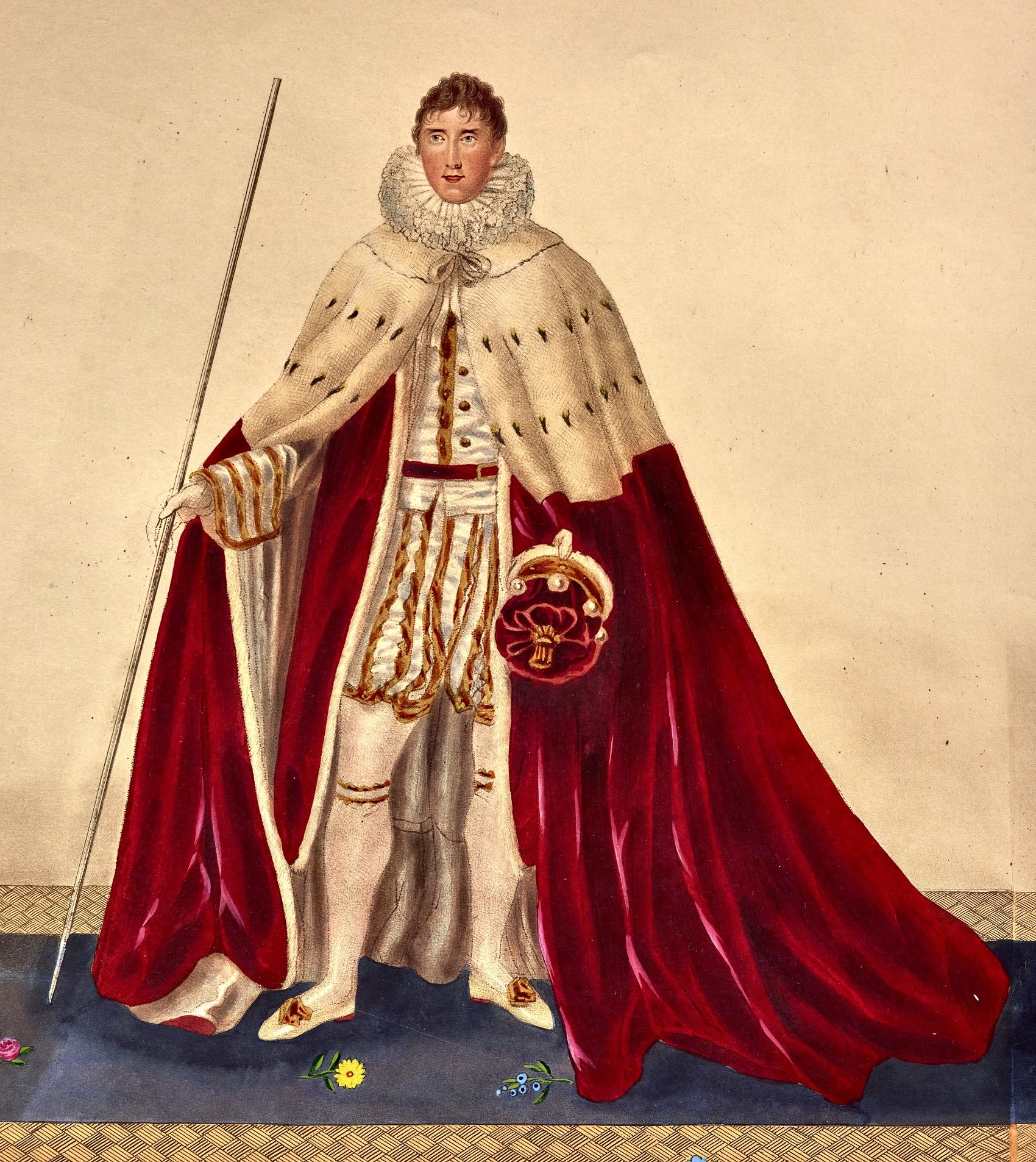
Lord Gwydir, Deputy Lord Great Chamberlain in Sir George Nayler, The Coronation of his most Sacred Majesty King George the Fourth (London, 1839).© Parliamentary Archives, LGC/8/1/11
Lord Gwydir, Deputy Lord Great Chamberlain in Sir George Nayler, The Coronation of his most Sacred Majesty King George the Fourth (London, 1839).© Parliamentary Archives, LGC/8/1/11
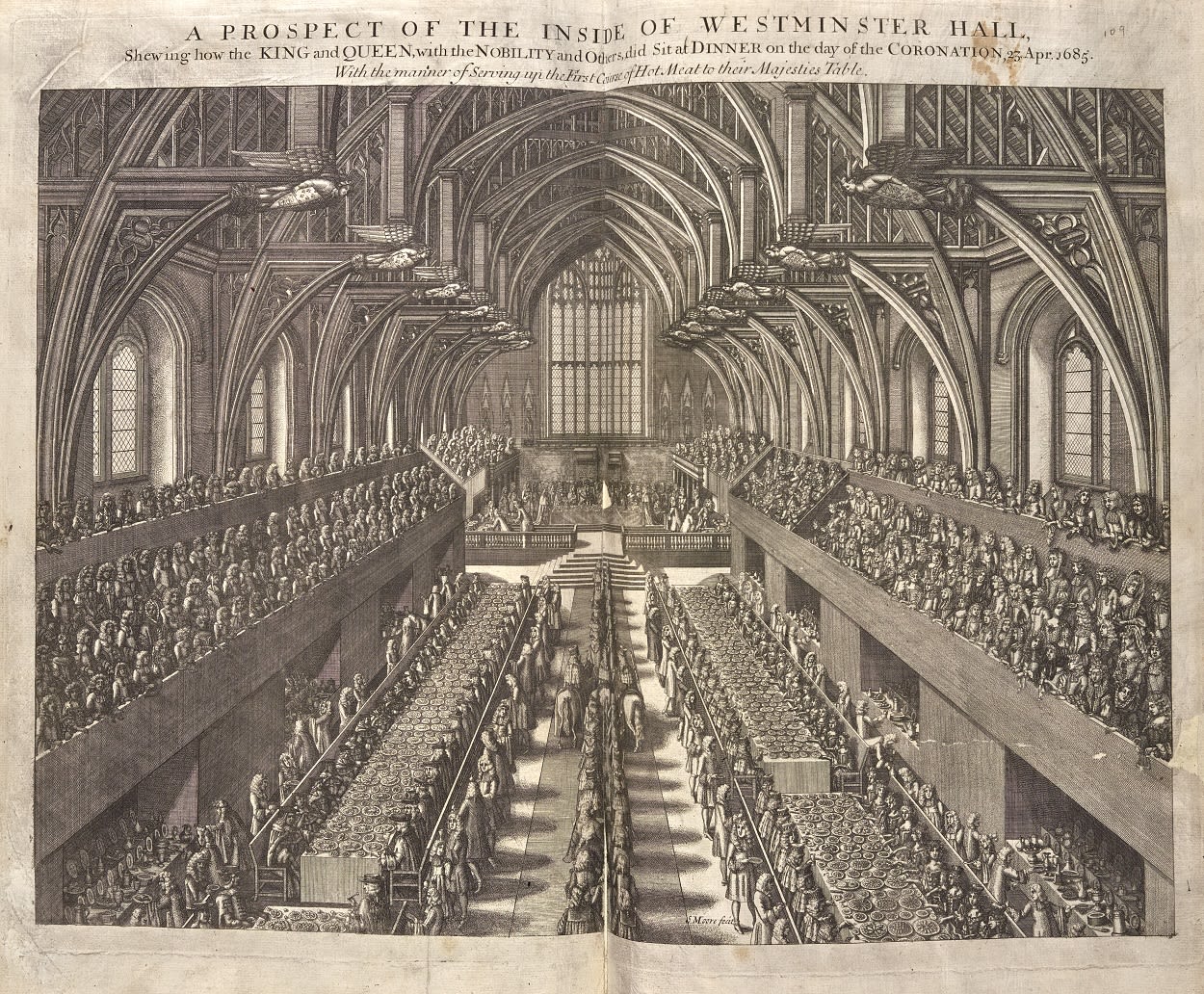
Serving dishes to guests at the coronation banquet, 1685, in Francis Sandford, The history of the coronation of ... James II (London, 1687).© Parliamentary Archives, LGC/8/1/6
Serving dishes to guests at the coronation banquet, 1685, in Francis Sandford, The history of the coronation of ... James II (London, 1687).© Parliamentary Archives, LGC/8/1/6
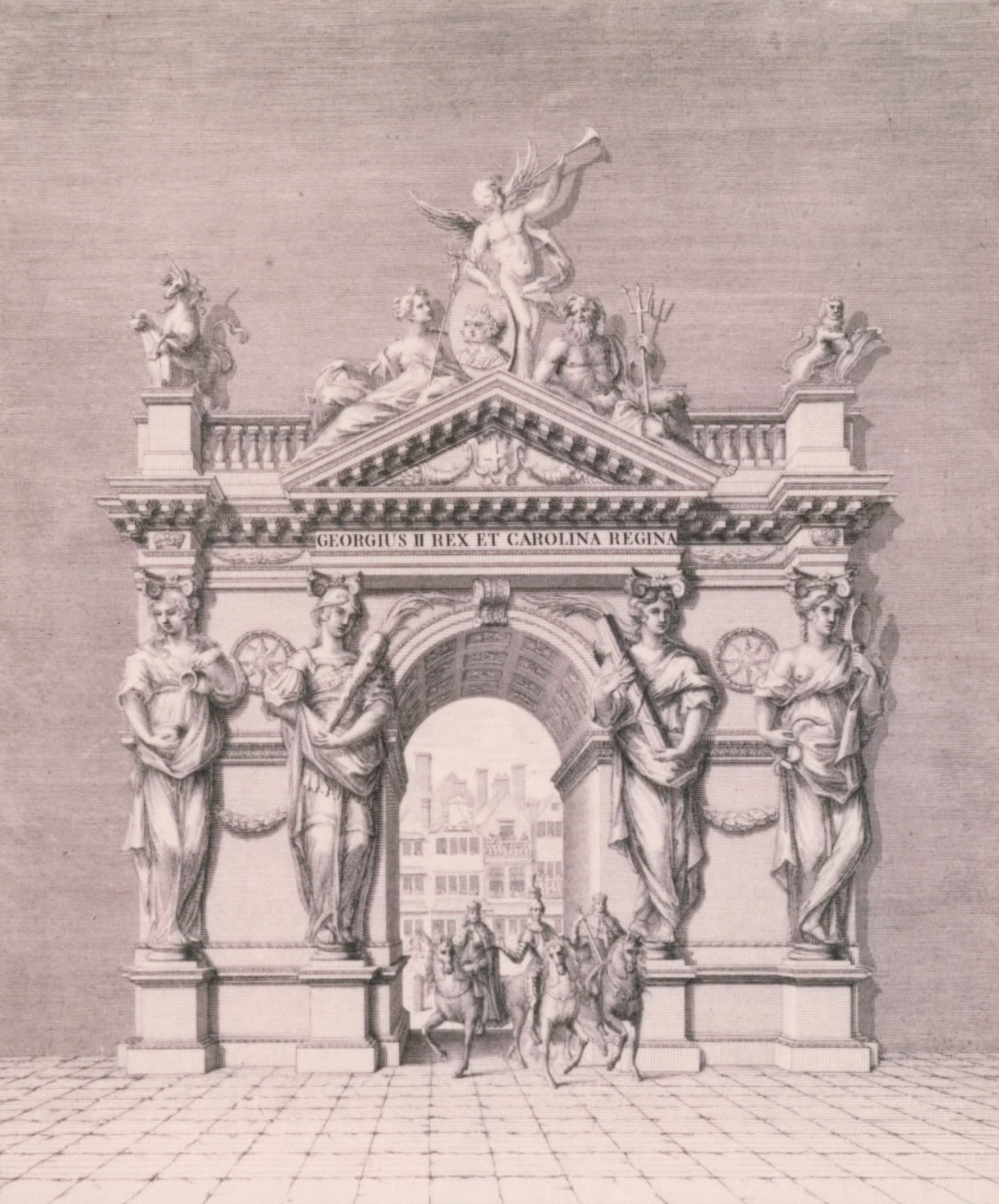
Triumphal Arch Erected and Painted on the West End of Westminster Hall for the Coronation of his Majesty King George the Second and Queen Caroline, Monochrome line engraving by Paul Fourdrinier, William Kent, © Parliamentary Art Collection, WOA 18.
Triumphal Arch Erected and Painted on the West End of Westminster Hall for the Coronation of his Majesty King George the Second and Queen Caroline, Monochrome line engraving by Paul Fourdrinier, William Kent, © Parliamentary Art Collection, WOA 18.
For the 1821 banquet a wooden floor was laid throughout the Hall above the flagstones.
A throne and table for the King was constructed on a raised platform at the south end and there were tables for guests either side of a thoroughfare with blue carpet.
Seated at the tables in front of the King were 336 guests including members of the House of Lords, bishops, judges, and the Speaker of the House of Commons. No women were among the seated guests.
At the King’s request the guests were dressed in a Tudor and Stuart style. Dining elsewhere were 2,000 other guests such as ambassadors.
Two galleries on each side of the Hall supported by iron pillars provided seats for spectators.
Hanging from the roof on hooks were 28 large chandeliers which dripped wax onto those below.
There was also lighting on the tables and in consequence the Hall became very hot.
Coronation Banquet of George IV in Westminster Hall, oil painting by unknown.
© Parliamentary Art Collection, WOA 5870. heritagecollections.parliament.uk
Tickets for spectators and guests were allocated partly by social rank and partly by the organisers who in the past had offered them for sale at high prices. The 1821 banquet was notable for the failed attempt by Queen Caroline, the estranged wife of the King, to gain entry to the Hall.
Assisting the guests was an army of servants and other staff. In 1509 these are likely to have included John Blanke, a Black trumpeter. In 1821 Bill Richmond, a former slave and a retired boxer was one of the ushers.
George IV Coronation Banquet Ticket
© Parliamentary Archives, LGC/5/2/14
Vast quantities of food were always features of coronation banquets.
Henry V’s coronation feast was held during Lent in 1413 consisted almost entirely of seafood including pike, crayfish, conger eel and salmon. After each course an heraldic sculpture made of marzipan was brought to the table. In 1429 dishes placed before Henry VI included a wheat porridge with venison, roast heron and a peacock.
In 1685 James II and Queen Mary were served 2 courses. The first consisted of 145 dishes arranged around pyramids of desserts – this was called service en ambigu. Some dishes were imported from the Mediterranean and the East Indies; the more unusual were not shared with the other diners.
The 1821 banquet was notable for the French style of cuisine favoured by George IV. Two courses and dessert were served at the King’s table using serving dishes from the Royal Grand Service. Plates of cold food for guests which adorned the other tables were supplemented by hot dishes served from nearby sideboards. To prepare the food temporary kitchens were built nearby.
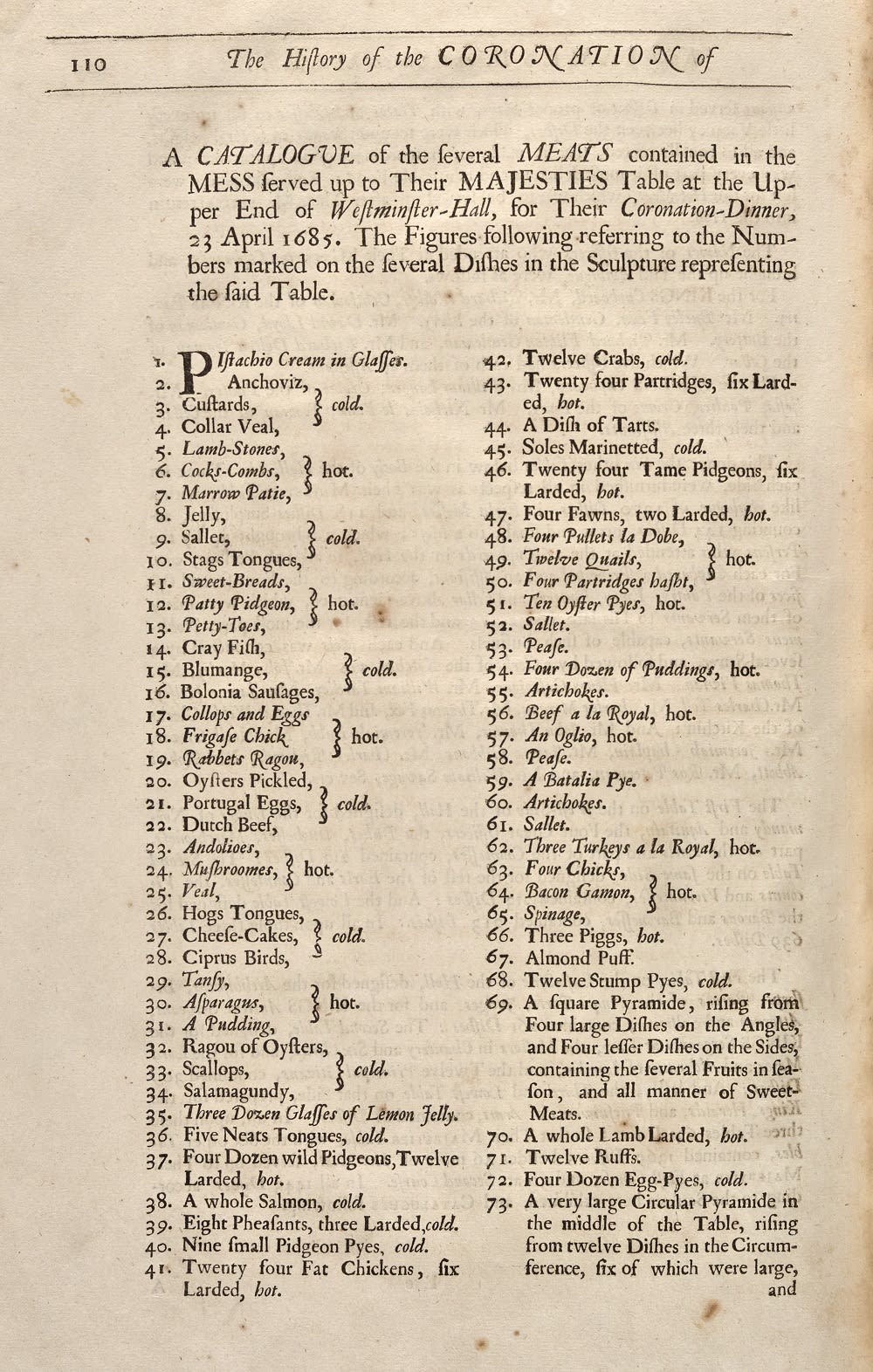
Ceremony underpinned events at a coronation banquet.
The bringing in of the food was accompanied by processions. In 1821 the first course was brought in by a procession of 47 people, some of whom were on horseback. The Deputy Earl Marshal rode a small white horse called Billy, well known for performing at Covent Garden.
Between courses the King’s Champion, always a member of the Dymoke family of Lincolnshire, entered the Hall on horseback wearing a suit of armour.
Mary Somerville, a famous Scottish scientist was a spectator at the 1821 Coronation Banquet. She describes the Champion entering the Hall below.
‘After every one had taken his seat, the Champion, on his horse, both in full armour, rode up the hall, and threw down a gauntlet before the king, while the heralds proclaimed that he was ready to do battle with any one who denied that George the Fourth was the liege lord of the realms. Then various persons presented offerings to the king in right of which they held their estates. One gentleman presented a beautiful pair of falcons in their hoods.’
Martha Somerville, Personal Recollections, from early life to old age, of Mary Somerville. With selections from her correspondence. (Boston, 1874)
The champion threw down a gauntlet at the north door, in the centre of the Hall and at the foot of the King’s table.
This was a challenge to anyone who disputed the Monarch’s right to the throne. Inevitably this sometimes resulted in a mishap; in 1685 the Champion bent down to kiss the King’s hand and fell off his horse.
The decision by later monarchs to economise meant that the 1821 coronation banquet was the last to be held in Westminster Hall.
Subsequently, the focus of the coronation shifted to the ecclesiastical ceremony held in Westminster Abbey.
A banquet in the Hall in 1905, following the Entente Cordiale between Britain and France, and similar events in 1906 and 1907 may have inspired the coronation lunch of 1911 in the Hall. This was attended by representatives attending the Empire Parliamentary Conference but not by the King. The lunch resulted in the formation of what is now the Commonwealth Parliamentary Association. Similar coronation lunches held in 1937 and 1953 were attended by the Monarch.
Westminster Hall continues to build on it's rich history and is still used for ceremonial events.
You can learn more about the Parliamentary Archives and its collections on the website.
You can find more about Westminster Hall on Parliament's website.
You can find information about visiting UK Parliament and Westminster Hall on UK Parliament's Website.
Watch our video, 'Spectacle & Ceremony: Coronation Banquets in Westminster Hall', produced in partnership with Royal Holloway, University of London.
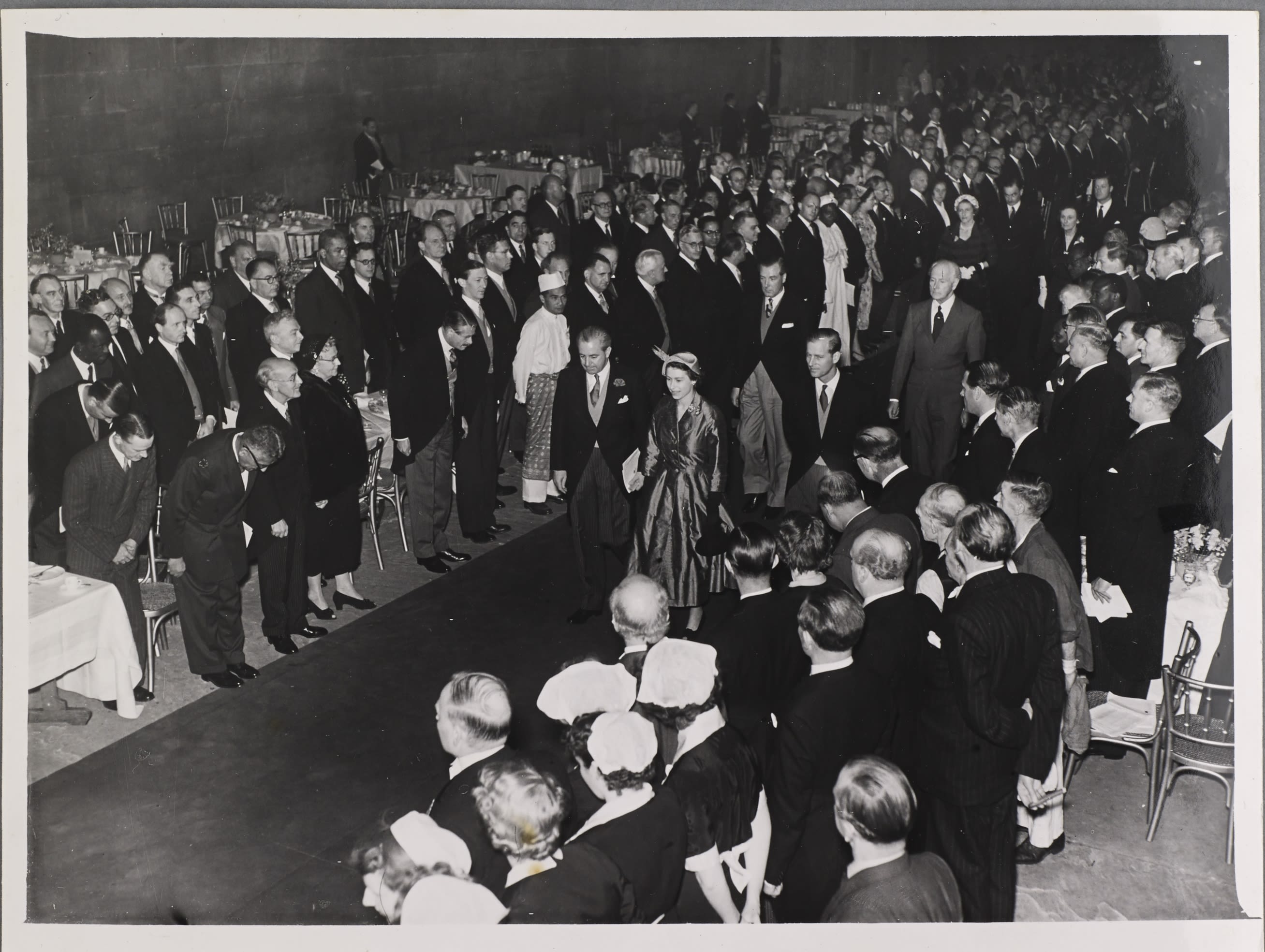
HM Queen Elizabeth II speaking at a Coronation lunch in Westminster Hall organised by the Commonwealth Parliamentary Association, 27 May 1953.
© Parliamentary Archives, CPA/2/2/11